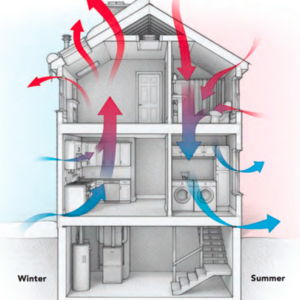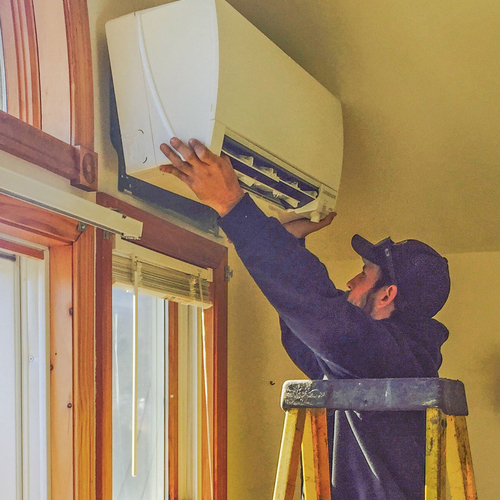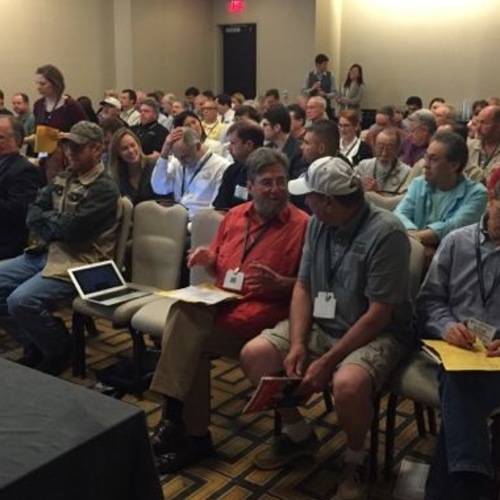
Image Credit: Hans Splinter, from flickr.com
Degree days are a combination of time and temperature. We looked at their uses and where they come from in Part 1 of this series, and now it’s time to go a little deeper.
The temperature enters as a temperature difference, ΔT (delta T), but it’s not the ΔT between inside and outside of the building. It’s the difference between the outdoor temperature and the base temperature. But what is this thing called base temperature?
Base temperature defined
Let’s start with the most general definition. The base temperature is the outdoor temperature that separates when the building needs heating or cooling from when it doesn’t. If the outdoor temperature is higher than the base temperature, the building’s heating system shouldn’t have to operate to maintain the desired indoor temperature. If the outdoor temperature is at or below the base temperature, the building needs heat.
That’s pretty straightforward. The base temperature is a balance point and has a nice, clear, conceptual meaning. It just doesn’t correspond to an exact, constant number, which is how it’s usually presented.
Factors that affect base temperature
I used 65°F as the base temperature in the previous article, but let’s examine that choice. Why is it the baseline most often used in the U.S. for heating degree days? According to the definition above, that would be the threshold at which you need to start adding heat to keep the building at a setpoint of about 68°F. (More on that discrepancy between base temperature and setpoint below.)
But in what building? With what kind of air and thermal control layers? How well is it shielded from changes in the outdoor environment? 65°F is probably about right for a building with a relatively weak level of air sealing and insulation. Maybe. Even a leaky, poorly insulated building won’t need heating at 65°F if it’s got a lot of internal heating loads (e.g., people or appliances). And a Passivhaus building may be fine with just the internal loads down into the 30s or 40s Fahrenheit, perhaps even lower.
Here are a few of the factors that affect what the actual base temperature will be:
- Indoor temperature. The warmer you keep it inside, the higher the base temperature will be.
- Internal heat gains. Lights, appliances, and people add heat to the inside of the building. The more they add, the less your heating system needs to supply in winter and the lower the actual base temperature.
- Rate of heat loss or gain. A building that loses heat faster in winter will have a higher base temperature than one that holds onto the heat.
- Season. Solar gains change throughout the year. Wind patterns change. How a building is used changes. Indoor setpoints change, too, because of the effects above but also because of varying mean radiant temperature. (Naked people need building science, you know.)
One interesting relationship came up when my colleagure Jeffrey Sauls and I were discussing this topic. When you make a building enclosure more energy-efficient with better insulation and air sealing, you reduce the heating base temperature. Jeffrey pointed out, however, that if you make the building more energy-efficient by using more efficient lights and appliances, the heating base temperature goes up because the heating system has to do more of the work. If you do it right, the building enclosure improvements trump the light and appliance improvements by a lot.
We should probably be talking about two different base temperatures: actual and standard. The actual base temperature is the one defined above. The standard base temperature is the one commonly used, and it’s not the same everywhere. In the U.S., we mostly use 65°F for heating degree days. In the U.K., 15.5°C (60°F) is the standard base temperature.
Difference between base and indoor temperatures
I was a little confused when I first started thinking about degree days. As I showed in my previous article on the topic, you can put DD right into the heat flow equation (Q = U x A x ΔT), but in that equation, ΔT is the temperature difference between indoors and outdoors. The ΔT used in degree days is the temperature difference between outdoors and the base temperature.
In the U.S., we use 65°F as our base temperature, but we typically keep the indoor temperature at 70°F. Why don’t we account for the other 5 degrees when we use degree days in the calculation?
The answer goes back to the definition of base temperature. Recall, it’s the balance point between needing the heating or cooling system to operate or not. If the temperature in heating season is above the base temperature but below the setpoint, the house is still losing heat through the building enclosure. It just doesn’t need the heating system to make up for the heat loss because the internal gains (lights, appliances, and people) add enough heat to keep the house comfortable.
So, there is indeed a discrepancy between the two calculations. Using degree days, you get the amount of heat the heating system needs to add. Using ΔT as the temperature difference between indoors and outdoors, you get the amount of heat loss through the building enclosure, which is made up by both the heating system and the internal gains.
What are you using degree days for?
Despite these problems, having a uniform baseline is still good for some things. Being able to compare one climate to another is the main one. Since I know both numbers use the same baseline of 65°F, I can tell right away that the 14,000 HDD of Fairbanks, Alaska, is much too cold a place for me. Give me Atlanta’s 3000 HDD… with a few excursions to the 7,000 to 9,000 HDD skiing climates!
If you’re doing calculations with degree days to determine the effectiveness of energy-efficiency measures, it’s probably worthwhile to, you need to choose a baseline appropriate to the building. Energy Lens, a U.K. firm that makes energy management software, has a great article about the intricacies of degree days. They also have one of the best sites for finding degree days for a lot of locations. It’s called DegreeDays.net, and it allows you to generate degree days for whatever baseline you want to use.
Resolving the base temperature problem
As I mentioned in the previous section, if you’re using degree days to compare climates, you don’t need to do anything except make sure the numbers you’re using all have the same base temperature. If you’re doing degree day calculations, you want to use a base temperature as close to the actual base temperature as possible. With data loggers or even just paying a little bit of attention to when the heating and cooling system come on, you can do better than using the standard base temperatures.
The more important thing, though, is to keep in mind that you’re not getting results to nearest BTU. Degree day calculations won’t give you results to the nearest 100 BTU and probably not even to the nearest 1,000 BTU no matter how good a job you do choosing the base temperature. It’s an approximate calculation, and it’s the relative changes that matter more than the numbers of British Thermal Units.
That doesn’t mean it’s not useful and can’t be immensely helpful. It just means you need to keep it in perspective and understand the limits.
Allison Bailes of Decatur, Georgia, is a speaker, writer, energy consultant, RESNET-certified trainer, and the author of the Energy Vanguard Blog. Check out his in-depth course, Mastering Building Science at Heatspring Learning Institute, and follow him on Twitter at @EnergyVanguard.
Weekly Newsletter
Get building science and energy efficiency advice, plus special offers, in your inbox.















15 Comments
Ok
thanks for coming up with that additional info !
What about the HDD data we find, is it fixed calculation from the base number ??
I do not understand why a more stable building ( PGH/PH ) where heating can be managed to not vary to more than 1degree k would use a lower base point ???
If i know that a building X with a thermo set point @ 21C , and heating kicks in @20c ,
why would i use 16-18c for HDD ?
If HDD is not a fixed value from base temps, it then serves no other purpose than comparative.
So is it a value hard calculated from a base temp that can be extrapolated, or is it recorded using some other "approximate" methods??
from Degreedays website
""""""""""""""""""""""""""""""""""""""""""""""
Although much of the theory behind these methods is sound, the results are usually a lot less accurate than many people realize. Such degree-day-based methods are central to many energy management programmes, and, as a result, important decisions are frequently based on figures that can be dangerously misleading to those that put too much faith in them.
"""""""""""""""""""""""""""""""
OUCH!!
Jin, the beauty of a modulating heat system is
it matches the heat source to the load regardless of heating degree mistakes. But one needs a starting point to guess at building the system to start with.
Same with outside set back and variable speed systems whether a mini split, central air or hydronic, all can be set up to alter the delivery to the need to increase efficiency.
AJ
I agree but i was more referring to the use of HDD in annual heat loss/potential for design and calculations. If the recorded numbers are modified/influenced by a few key parameters, rather than hard recorded temp differences, the results of all heat loss calculations based on HDD start off with some serious derivation from reality.
Not sure i make any sense here, please tell me if don't.
Jin, it's a use and learn thing.
HDD is a starting point. Add experiece in installing systems either as a GC or as an HVAC sub and as you know homes get heat, mostly too much because too little is very painful for all.
Start to run the numbers on homes that interest you and you can do things like Dana does, you can collect the utility bills for example to guess how BTU and you can play with knowing delta T per day per hour, you can do like Marc Rosenbaum and really start to know what's happening. He offers classes, you may be interested in. Purchase "Modern Hydronic Heating." Great book though not concentrated on mini splits, still lots to learn.
Dana is the amazing number crunching man of GBA, read everything he posts along with Marc Rosenbaum.
Jin,HDD are good to compare
Jin,
HDD are good to compare (to each other), provided the base number (HDD18°C for example) is the same.
If a building has the thermostat set to 21°C, there is no reason the heating would come at 20°C, provided it is working right.
As to why you might use HDD 16 (or 18), my understanding is this is to account for internal gains. If your average gains (whatever the source) amount to 5°C worth of consistent heat, then you no longer need to heat the house (via heating equipment) to 21°C. Your balance point is now 16°C. Therefore, it makes sense to use HDD 16 to estimate annual heat demand, since your heating equipment will not come on if the ambient temperature is above 16°C (in theory).
This is the point Alex is making when he explains the difference between base and indoor temperatures. Between balance point and set point (of thermostat).
This is especially true for tight, well insulated homes, as internal gains can often be significant percentages of the heat loss, compared to similar sized homes with typical envelope design. Hope that helps.
cheers
65F Baseline For HDD
There are many factors in determining a building's thermal performance and energy use, solar gain, building mass, R-vaulues, ach50, shading, Earth coupling, etc.
More efficient lighting and appliances have lowered internal gains and should be accounted for. A 60 watt equivalent LED uses 9.5 watts, in the winter this is heat the furnace will now have to provide. Positive from a CO2 standpoint, better to heat your house with a high efficiency gas furnace than incandescent lights.
Heating Degree Days and Cooling Degree Days are a weather record tool, useful for real time calculations for fuel usage on both a small and large scale. I like to use HDD for measuring building efficiency improvements, with metered gas and electricity much can be learned by normalizing heating seasons.
Calculating the base
degree days dot net also has an article on regression analysis of historical data to find an accurate base temp. I tried to do that with my home heating energy & temp data, but I think my temp isn't controlled super well, so finding best fits was a little challenging.
Jason :
somewhat deceiving ...
Why include an approximate margin in a specific number
when it is much easier to calculate internal gains based on design and or many studies/average??
Jin,
I will try to clarify as
Jin,
I will try to clarify as best I can.
I agree it is easy to come up with some specific numbers for internal gains. Like 3200 btu/hour, for 4 person occupancy. If you are doing a design heat loss, you can just deduct the 3200 from it. Simple.
Using averages, or studies might help, depending on what values they give, or how relevant they are. Such data comes with it's own inherent level of inaccuracy, of course, as they are generic and do not account for your particular circumstances. Not everyone does 4.7 loads of laundry a week, for example. Depending on what you are modelling, this might be fine.
As Doug pointed out, internal gains are likely decreasing on the whole, as more efficient products come on the market. This decrease might be partially offset because we tend to use more heat generating gizmos than our parents did, but by how much I don't know. Probably some studies out there to tell us, but I haven't seen one.
However, if you are doing annual heat loss, using HDD, this 3200 is not as useful. You need a way to apply those internal gains to the HDD for your building's climate. By lowering the balance point of your building (because of internal gains), you lower the effective HDD for your building. Then you do your annual heat load calculations with this new, lower value.
cheers
Jason
this part i understand ..
but this results in an approximation of internal gain compensation
same as calculating the internal gain from studies data etc..
Internal gains on a specific project can be calculated to a certain precision.
Laundries do not add that much heatgain, recent refrigerators are all within the same ballpark of annual concumption,water heaters have a similar standby heat loss etc..
Internal heat gains need to be calculated for heat load, and their share of it is growing with insulation level ...while your there and have the numbers nah ?
Maybe it is too complex to use with an "average" annual HDD formula neway.
And it is probably much quicker to assume a certain base point to the HDD .
Is it the point of it ? simplicity ?
Jin,
I think so. Part of it
Jin,
I think so. Part of it is just converting units. You can't directly apply 3200 btu/hour to 7000 HDD65 without doing some kind of math first, but I sense you understand that even if you don't agree with the accuracy, or usefulness.
I expect that people designing buildings where internal gains can really matter, or cause problems (like overheating) are not using estimates or averages. If you're building a room that can hold 1000 people, your gains can go from background (<1000?) to 250,000 btu/hour in the time it takes those people to walk in. This requires a higher level of precision, like what you are talking about?
For my own purposes, this is ideal, however. Modifying my balance point with expected (averaged, based on studies or a rudimentary schedule of occupancy) provides me with an adjusted HDD value. Keep in mind, if you are using HDD to estimate annual heat demand (or CDD for cooling) you are already accepting a certain level of inaccuracy.
Again, for me, the takeaway is this is a useful method to arrive at an annual heat demand that can a) give me a good idea of what my proposed envelope will cost to heat (in $, or kWh) and b) help me optimize the size of a mini-split.
cheers
ok
well as i said, i was deceived by the simplicity of using HDD as a multiplier for annual heat loss base calculations .. anyhow
So let's assume that we are using adjusted HDD base, for khw/y heat loss maths,
how accurate are the results ?? i have looked very quickly through HDD definitions,
but never read about any accuracy numbers... just to have a rough idea
thanks again for clearing that up, thanks mr Alex for bringing this subject up!
Internal Gains
This link may help explain how to determine internal gains and the balance point of a building. 1979 vintage but I believe the information is still valid.
http://web.mit.edu/parmstr/Public/NRCan/nrcc18354.pdf
More information on balance point calculation.
http://www.ced.berkeley.edu/~crisc/oldstuff_Arch140_11/Readings/Files/16_BalancePoint.pdf
I found another good article on the base temperature at:
https://www.degreedays.net/base-temperature
I'd say the two main additional points from that article are that:
a) The base temperature for CDD is typically different (usually higher) than the base temperature for HDD.
b) Intermittent heating/cooling is another key factor that affects the base temperature.
12 degrees C is the base temperature that separates heating from cooling in my house.
Log in or create an account to post a comment.
Sign up Log in